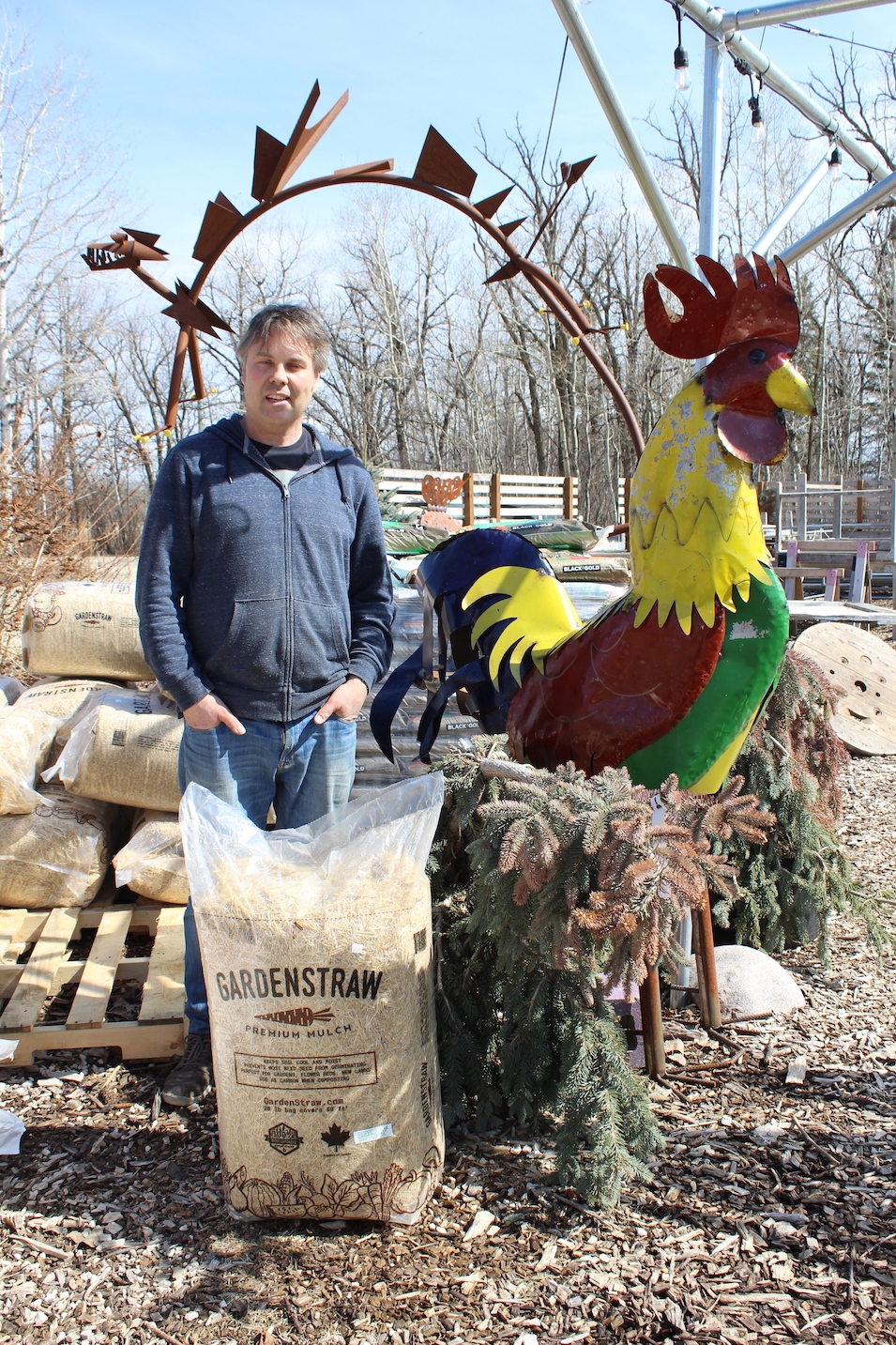
Some call it spring while others call it gardening season. If you’ve got a green thumb or you just enjoy the feeling of warm dirt in your hands, gardening can create a therapeutic release of pent-up winter energy.
But there’s a lot to know when attempting to create a beautiful yard-scape that lives up to the image in your head. Thankfully, we have a bounty of nurseries and lawn experts in the southeast with knowledgeable staff who have a unique understanding of plants, shrubs, trees, grass, soil, fertilizers, and pest control.
Tyler Whitley, of Red Valley Landscaping and Plant Market, says that container-gardening is the number-one trend for accessorizing outdoor living space. Garden pots offer flexibility and ease, allowing even small yards to flourish and grow with colourful and edible plants, without the work of a garden. Tomatoes can grow on the deck and flowers in any corner of the yard. Pots can be moved to optimize light and water sources.
Water Wisely
“It’s best to water when [the soil is] dry to the touch about one knuckle into the top layer,” says Whitley.
Whitley adds that proper watering is also essential when transplanting. The process of removing a plant from its container to a new one creates a shock to the root system. Two light waterings will set the new soil around the roots and provide them with adequate moisture for a good start. Allowing plants to adequately dry between watering then builds a strong and healthy root system, forcing them to reach deeper for water. Watering in the morning gives your plants an opportunity to dry throughout the day. Watering at night can create root issues as the soil will retain the moisture longer during the hours of darkness.
“One of the biggest tips that we give customers is to not overwater their plants,” says Arielle Macleod of Glenlea Greenhouses. “Succulents and cacti are very sensitive to having too much water in their soil, which is why a well-draining soilless medium [should be used]. Never use topsoil or a soil used for containers [with these plants] since it contains a gel that holds water. This can cause root-rot or encourage fungus gnat larvae to thrive.”
Nourish and Groom
Next to watering, feeding and grooming are essentials that many gardeners overlook.
“Use an all-purpose plant food… when the soil is halfway dry,” says Whitley. “Fertilizing dry plants runs the risk of burning the root system. Fertilizing every 10 to 14 days keeps up with the nutrient demand of the plant. [Also, make sure to] groom the plants. Trim and shape them every two weeks with scissors. [Literally], give them a ‘haircut.’ This gives the plants a healthy, luxurious growth that is picture perfect. Deadhead blooms (remove the dying blossoms) as they fade. This encourages more blooms to form.”
According to Lisa Kackenhoff of Kackenhoff Nurseries, manure can be a useful fertilizer in certain applications, but it can sometimes promote disease. Bone meal is a better option for plants such as peonies.
Eliminate Garden Pests
Humans aren’t the only ones who’ll be enjoying all of the colourful plants in your yard this summer. Kackenhoff says there are innumerable ways to keep pests from ruining your greenery. If deer or rabbits are a problem, there are many plant shrubs, herbs, and perennials you can use to deter them, such as alyssum, marigold, basil, mint, columbine and red elderberry.
Placing crushed eggshells under and around your newly planted tomatoes will ward off cutworms and add calcium to the soil to help fight against blossom-end rot of the fruit. For fruit trees, roses, and many ornamental shrubs, using Dormant Oil and Lime Sulphur Mix can kill overwintering insects and eggs and prevent a number of diseases. Apply this only when the plant has become dormant.
MacLeod believes all-natural pest control is the best method for edible plants.
“To prevent pesky aphids and other leaf-eating insects from getting into your garden, many gardeners use marigolds to deter both animals and insects,” says MacLeod. “Marigolds have a distinct smell similar to skunk spray that helps to ward off anything that might come near the plants.”
Lily beetles are a pest that many proud lily growers became familiar with last summer. MacLeod says that the best method of controlling these naturally is by removing them manually.
“Go into the garden and squish the beetles that are eating the lily leaves,” says MacLeod. “In the fall and spring, you can clean the soil around the lilies. Look for the beetle eggs and burn them to prevent them from hatching. These eggs are a reddish-brown colour and should be removed if found. This will help prevent more beetles in the spring. These beetles do travel from garden to garden, so it might be difficult to permanently rid [your plants of them] but they can be managed if one is determined to keep their lilies year after year.”
Attracting Bees and Butterflies
Where some insects are considered pests, others make for an exotic and useful addition to our garden beds. Butterflies contribute to the beauty of our backyards with their colourful and fairy-like nature. According to MacLeod, Asclepias—otherwise known as butterfly weed—is the perfect plant for attracting butterflies, especially Monarchs. Asclepias provide brilliant blossoms and are an excellent source of food for butterfly caterpillars.
Bees, too, are an important part of the garden ecosystem, pollinating our plants and enriching our harvest of fruits and vegetables.
“Many perennial species will attract bees, especially flowering shrubs like lilacs,” says MacLeod. “Having clover in your lawn… also helps to attract bees. Other perennials are bee balm, stone crop, coneflower, and rudbeckia. Bees are very important to the success of many of the foods we eat, so we need to make sure we provide sources of food for them.”
Planning Garden Beds and Creating Lusher Lawns
If you’re considering adding a new garden bed this year, some planning is essential.
“When planning a new bed, take a few days to determine how much sunlight the area gets,” says Kackenhoff. “Go out every two hours from dawn to dusk and snap pictures from three locations around the new site. Compare [them] at the end of the day to see the sun to shade ratio. Then plant shrubs and perennials that require that type of lighting.”
For a lusher lawn, Kackenhoff discourages the use of regular soil, which can be laced with weed seeds.
“Use a sterile mixture of vermiculite, peat moss, fertilizer, and lawn seed,” says Kackenhoff. “You will have a thick green lawn in no time.”
She adds that covering the newly seeded area with natural, untreated burlap helps protect it from birds and the elements.
TenRoc Construction, specialists in lawn and yard care, offer practical advice for keeping your lawn beautiful all summer long.
“Don’t cut your grass too short,” says Jacelyn Boone, of TenRoc Construction. “[This makes it more] susceptible to weed invasion, drought and heat damage.”
Some other common mistakes, she adds, are regularly bagging grass clippings, which deprives a lawn of nitrogen and nutrients stored in grass, which is a natural fertilizer. She recommends using a mulching mower and occasionally feeding it back to the lawn. Annual aeration of the lawn is also important. An aerator pulls plugs of soil from the ground’s surface, allowing the lawn to breathe and breaking up compacted soil. The process also makes the ground more permeable to water and fertilizers, getting them right down to the roots.
“My lawn has patches that are discoloured from when my dog relieves itself,” adds Boone. “Saturate the affected area thoroughly with a hose once a week, or pour a pail of water over the area right after the dog urinates.”
While our local nurseries are bursting at the seams this year with all of the yard and garden products you’ll need, don’t forget to tap into their valuable wealth of knowledge and training, offered at the simple cost of a smile and a thank you.




















